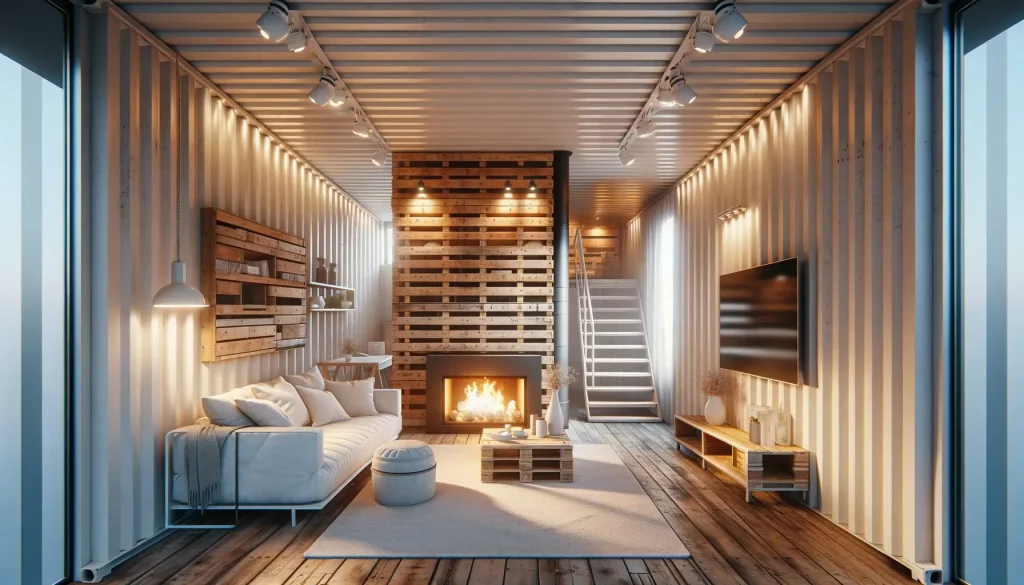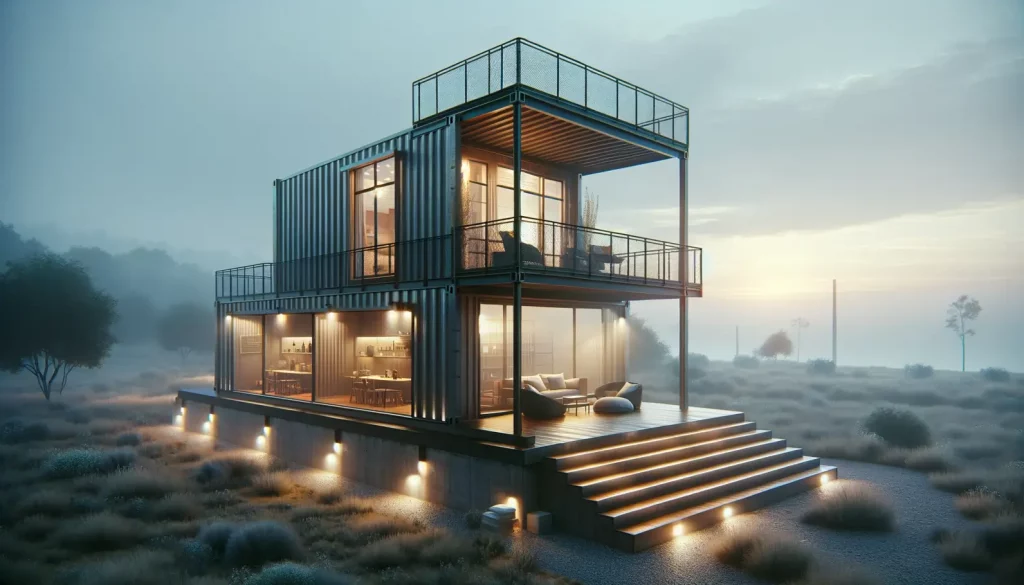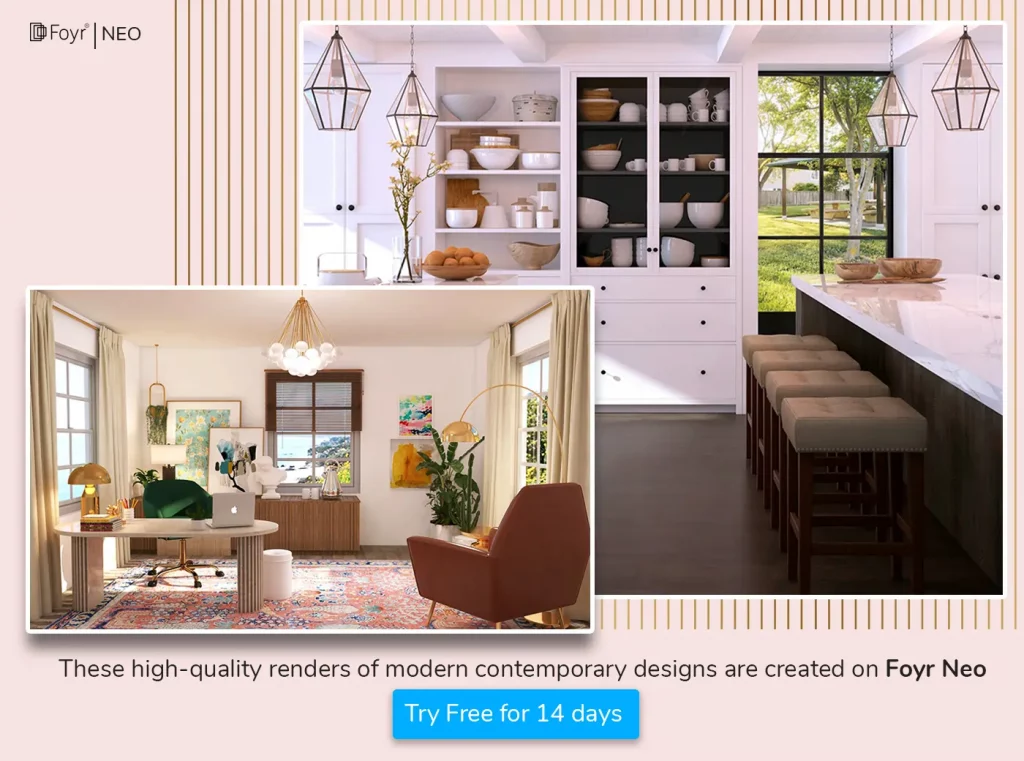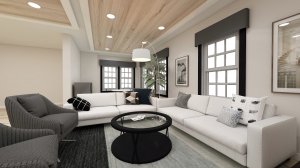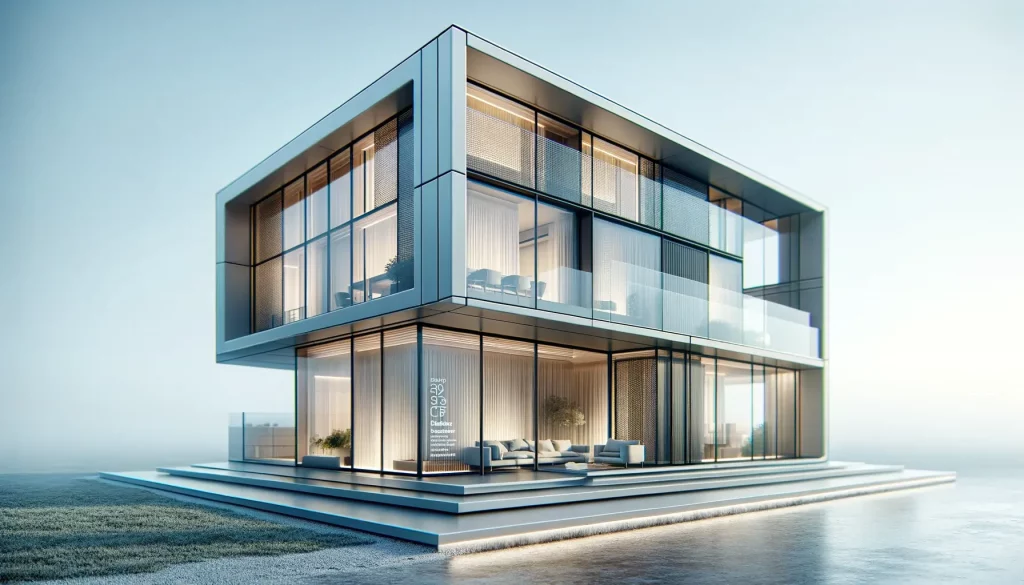If you’ve been eyeing different ways to bring freshness to your designs and blur the lines between indoors and outdoors for your clients, a container home would be a great place to start. Living out of modified shipping containers is a fast-approaching, sustainable, and cost-effective, and time-efficient method that pioneers design into the future. A lot of people, especially in the US, are catching up to this trend. More than just being iconic, custom container homes are more functional, aesthetic, and flexible to work with, than traditional homes.
With the right interior, exterior, and design features, you can help your client set up warm, chic, rustic, or contemporary-style container homes anywhere they want, on any landscape, and make the place feel like home instantly. Let’s walk you through how you can design and decorate the ideal container house, precautions to keep in mind, and why it has the potential to become a fun, futuristic place to live.
What Exactly Is a Shipping Container Home?
When you visit shipping have you seen shipping containers lying unused in such large numbers? It’s pretty expensive to recycle them or to send them to other countries, so they are preserved until they can be used to service storing and shipping requirements.
By bringing shipping containers to the shore, and incorporating state-of-the-art interior design and exterior elements to make the place look cozy and luxurious, you create a dream home aka a container home. You can have a modular/prefab construction and then shift it to your client’s site.
| Bill Oatfield, in their book Shipping Container Homes, says there are more than 50 Million surplus containers in the United States alone. |
Even if your clients are skeptical about living in modified container structures, they can still make use of it by having a part of their living or recreational spaces designed in the container, alongside their traditional homes.
It’s a superb solution to the housing, home building, and environmental crisis we’re at. It’s multi-functional and can be used as a
- Primary residence
- Container guest house
- Getaway home
- Gaming unit
- Home container office
- Workshop
- Dormitory/ places of rental accommodation like in Airbnb
- Studio to shoot videos exclusively
- Peaceful sleeping or meditation room
Read also – Why Do You Need an Interior Design Sketching Tool?
Pros and Cons of Building and Living in a Container Home
|
Pros |
Cons |
| ✔️ Foundation requirements are simple | ❌ Needs special equipment like forklifts and cranes to be installed. |
| ✔️ Can be set up and inhabited in a short period, additions are easy to make and inexpensive to build. | ❌ Obtaining building permits might be an issue. |
| ✔️ Container homes have steel exteriors, which conduct heat very well. Highly durable, waterproof, and strong. | ❌ Without insulation, container homes struggle to balance heat and cold. |
| ✔️ Excellent to withstand storms and winds blowing at 175 miles per hour. They are eco-friendly too. | ❌ In temperate regions, moist interior air condenses against the steel and can make way for rust. |
| ✔️ The perfect building material to be stacked, moved, cut, or molded into any type of home. | ❌ Containers may have cargo spillages on the floor, which need to be removed with utmost care. |
Considerations for Container Home Design
- Call the building administration at the county offices and check with them about other recycled shipping container homes in the neighborhood.
- Consider zoning, building codes, and laws before buying the property or the container.
- Test the soil for water-retaining properties and potential flood damage.
- Consider the chances of a fire happening, incase your client is situated in areas where bushfires are common, like in Australia.
- Conduct a dye test to assess the efficiency of the drainage system in the neighborhood.
Read also – How To Become a Certified Interior Designer Without A Degree in 2024?
How Are Container Homes Built?
A single container is about 8 feet wide and varies in height. Typically, container homes are built by combining two or more containers, either by stacking them one on top of another or by modifying them to add new elements to existing container builds.
It’s made from weathering steel, which is corrosion-resistant braves any weather, and can withstand earthquakes like those that occur in California.
Curating the site and floor plan
Anyone can give you a vague and flowery design of the space, but only a qualified architect/interior designer can give you an accurate floor plan and blueprint detailing every single inch of space, its usage, and its properties. To achieve that level of precision, you need a professional and advanced floorplanning tool like Foyr Neo.
Before you start designing, measure everything in the space, including space for furniture, rooms, circulation, extent of open space desired, etc. Then, let your client make a wishlist of all functional elements to go in the space – bedrooms, baths, kitchen, dining room, living space, garage, etc. Develop rough square feet of each program requirement, and create schematic design including blueprints and elevations.
An open floor plan combining the kitchen, living room, and dining room is ideal for a container home and optimizes passive system design. Typically, an average container house will have one of the following floor plans:
- One bedroom, one bath + lounging deck
- Two bedroom, one bath
- Three bedrooms, 2 baths
Read also – How to Draw a Floor Plan & Top Mistakes to Avoid
Foundation and framing
Foundation decision depends on site conditions, overall building design, climate, local market preferences, construction costs, and water table depth, along with others.
| Brek Candell, the Director of Design at Three Squared, Inc., says, “You need to consider the hydrostatic pressure, frost depth, and the possibility of pest attacks when devising a foundation for your container house. The bigger and heavier your house is, the larger and deeper your foundation needs to be.” |
To elaborate on Brek’s recommendation, hydrostatic pressure is the pressure exerted by water in the soil on the structure you have erected. Its inherent nature is to push against your building, so you need to understand the water table of the area before you start designing the foundation. Don’t forget the frost depth either. It’s the level till which the frost goes deep during peak winters. Depending on your topography, your client may face perennial winter, or only a few months of winter, but if it’s going to be snowing and the land is going to be frozen for a while, you definitely need to consider frost depth.
Foundations go below the point where the ground freezes. Ice expands naturally, and it will push your foundation in its course. That’s why you need to go below the level. Pests are no strangers to country-side homes. To steer clear of them, follow the perimeter of your client’s house, draw a line around the base of your house, and lower the house into the ground until it’s deep enough and below the frost line. That’s usually the rat wall, which is important to keep pests and rodents away from your home. To make sure you leave no stone unturned, it’s better to consult with a structural engineer, get their calculations, and incorporate them in your design, so you don’t accidentally oversize the foundation and cost the client a lot of money.
Lighting and ventilation
Add skylights to the container if you aren’t stacking them up. You can install thermal chimneys that moderate hot air to make way for free ventilation. Get operable windows on the south exposure. If a room can have windows on only one side, get 2 big windows on the same side. Take ventilation to the next level by placing wing walls that stand perpendicular to the wall on the windward side.
You can use the sun’s energy for the heating and cooling of the container home, and take advantage of the connection it has to nature. Ensure the interior spaces requiring the most light, heating, and cooling should be along the south face of the building. Less used spaces can face north.
Read also – The Importance of Lighting in Interior Design
Kitchens
Like any other house, a container house can have any type of kitchen – be it contemporary, traditional, or casual. To make the kitchen larger, you can place two containers side to side. Here are a few things to bear in mind when designing kitchens in container homes:
- Incorporate creative/fun elements in the kitchen, like an accent wall, fun centerpiece, etc.
- Bring cabinets up to the ceiling and ensure with glass front doors to the cabinets to feel airy.
- Don’t go overboard with stainless steel appliances, or they will exude an industrial look.
- Have countertops around wall ovens.
- Ensure to buy strong, good-looking cabinets
- Use space-saving, multi-purpose furniture.
- Rethink the kitchen island, and incorporate dining tables instead.
Read also – 34 Beautiful Modern Kitchen Design Ideas for 2024
Container Home Interiors
A shipping container house is basically made of metal and the like, which has a cold, industrial feeling to it. If you need to convert it to a warm, DIY tiny home or a luxurious residence, you will need to inject personality, and character, and bring in a lot of meaning to it. Good, soft, and textured interiors help you achieve that. Make sure you do the interiors after the container has been lifted and placed on the foundation.
Flooring
Go for timber flooring if your client wants to have an intimate, and tactile feeling every time they walk into the house. One note of caution – do not retain the wooden flooring your container originally came with. When it was fully functional, plenty of pesticides and chemicals would have been sprayed on them, and would still be present on the floor. Go ahead, rip up the flooring, and affix anew. If not, at least give it a good wash with industrial epoxy or polyurethane coating.
Stay away from thick carpeting the floor. You will only add to the heat during the summer, and the fabric tends to absorb moisture from the air inside and make the air conditioning work harder. Instead, go for lighter carpets and area rugs to alienate space and soundproof. Carpets, drapes, and fabric-covered furniture aren’t advisable.
Read also – How Interior Designers Choose Flooring for Interiors
Fireplace
Another way to connect you to the exteriors is with a fireplace in the living room. Makes the entire space comfy, and homey. Add a few white track lights or recess lighting to the background and you have a dreamy home.
Read also – 14 Wonderful Fireplace Decor Ideas For Your Fireplace Mantel
Pallet wall
Add a smidge of country style to the container house with a pallet wall, that you can use as a feature wall, a dividing wall between rooms, or a backdrop to your client’s TV. If you have excess distressed wood lying around, you can gather it, arrange it in a sequence, get it coated with varnish, and use it anywhere in your container home.
Read also – How Interior Designers Choose Wall Paint Colors for Interiors
Stairway
Does your client love having a stairway inside the house leading to higher floors? If they have expressed interest, you can surely make it happen by cutting a pathway through the roof’s load-bearing steel, provided you don’t plan on placing heavy equipment up there.
Read also – 14 Different Types of Staircases
Container Home Exteriors
Soundproofing
If your client lives in a stormy region, they are likely to experience fierce winds and storms every now and then. Living in a complete metal enclosure, you can imagine the level of sound the container will make when the winds howl through the area. Make sure to soundproof the house from the outside, and your client will thank you for it.
Switches
Place electrical outlets outside. Don’t use regular switch boxes. Go for thin switches that fit in the walls and those that don’t conduct electricity, to be on the safer side in case of wiring mishaps.
Doors and windows
Installing floor-to-ceiling windows or French windows in the container house is a brilliant way to bring the outdoors in. You become one with nature, and the colors of the landscape bounce off your house’s reflective surface to present a visual treat.
Stiffen the metal around the window/door hole which will prevent the metal from warping or bending. If you’re using standard window frames, slot them into wooden framing and screw them in. You need a metal frame and seal the gap so moisture cannot get in.
If you want to go for a rollup door, get one that’s at least 4-10 feet wide, but please note that these doors may not look as aesthetic as traditional doors and may also cause issues during the insulation phase. Alternatively, a traditional door, 3×7 feet attached with a steel frame would make an excellent door to the container house.
For windows, you have two efficient choices that work out well in the long run – vinyl-type windows, and metal storm windows. How to cover gaps around door and window frames when installing? Easy. Install steel roof flashing building material on windows and door trims.
Read also – 9 Best Contemporary Interior Design Ideas For Your Home
Insulation needs
The main areas you need to insulate are:
- The exterior underside between cross-member support beams
- Interior side walls
- Interior ceilings
No matter where you insulate, just remember – all insulation should have a vapor barrier facing toward the living area. To instruct your contractor on what type of insulation you need to go for, refer to the following table:
| With an interior framework of 2×2 | Standard rolled fiberglass |
| Without framework | Foam panel |
Place studs every 2 feet – 4 feet to allow easy attachment of standard 4×8 drywall or other interior paneling material. Thin layers of fiberglass insulation under the paneling will help retain heat in the winter.
Decks
A wonderful addition to your client’s home for them to spend quality time with their loved ones. Install ones from pressure-treated lumber. You can use specialized anchors/wood beam ledgers to attach the deck to your container home.
Read also – deck planning software
Roofing
| Brek Crandell, the Director of Design at Three Squared, Inc., says, “Water is the #1 enemy of any building, and the roof is the most important piece in keeping water away from your building. |
This applies especially to container homes. The reason is, the container roofs aren’t meant to bear weight. The goods are usually stored inside the storage container and so the durability and real strength of the container is in its rock-solid floor. The roof, however, can handle weight and water runoff, but cannot withstand water clogging – it’s susceptible to collapse with prolonged water logging, or forming rust. A sloped roof is the best as it smoothes the water run-off process and minimizes water-related damage to the steel.
You can have any roof – flat, patch, rooftop deck, shed, or living roof. As long as it channelizes water to the gutters, and helps runoff, it’s good to stay. A pro tip would be to check what other container houses/ traditional houses in the neighborhood have and adopt a slightly similar style. Will you be stacking containers one on top of another? Get a hip roof that has a short installation time, and you can multi-purpose it for harvesting rainwater, generating solar heat, and sneaking in additional natural light.
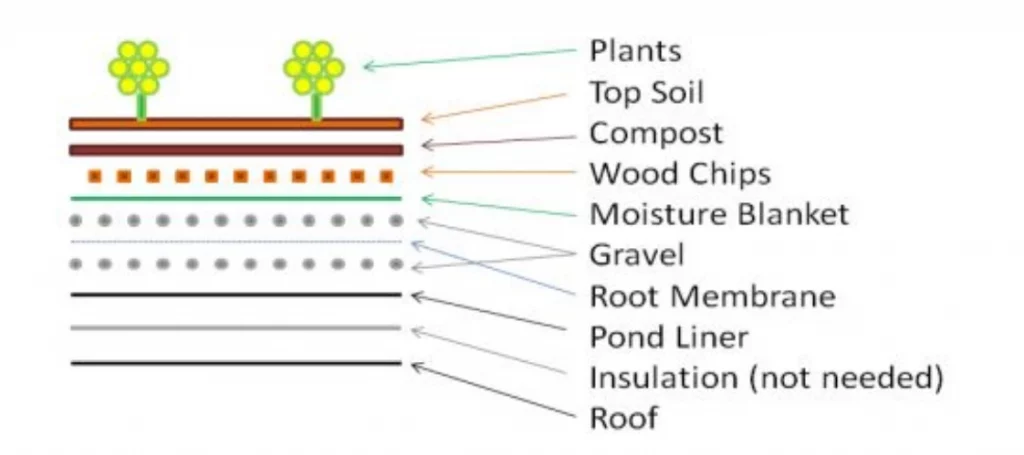
Bill Oatfield, in their book Shipping Container Homes, makes a great point. If your client wants a roof rife with plants and life, a living roof is a beautiful option. It is made of plants and moss and creates a barrier between the outside elements and the container. Helps you keep the temperature down in hot regions.
When you design roofs, ensure you have small vents to keep air from flowing in and out and enabling container condensation, and close the vents at night to prevent heat from leaving the living space.
Read also – How To Calculate Commercial Rent On A Monthly and Annual Basis?
Painting and wall decor
Since you’re working with used metal rectangular or cube containers, a fresh coat of paint will feel like a breath of fresh air when your client starts living in the house. There are, however, a few points to note about what type of paint to buy for which area of the container house. In warmer regions like Colorado, Texas, and Dallas, reflective paint for the exterior to bounce off the sun’s direct rays, and ceramic-based spray paint for the interiors. The ceramic paint blocks the sun and reduces heat gain. For steel containers, you can choose rust-inhibiting urethane enamel paint on the exteriors.
Maintain medium dark colors for floors, and light colors for lightweight walls to ensure your client gets maximum light and reduces energy consumption.
Read also – 28 Best Wall Decor Ideas To Decorate Your Blank Wall
Common Mistakes Designers Make When Designing Container Homes
❌ Choosing properties too close to water bodies.
❌Not planning as per regulations
❌ Buying containers with wrong heights and sacrificing precious headroom for insulation
❌ Buying a container without evaluating it in person
❌Getting the wrong type of insulation
❌ Cutting too much steel from the container
How Can Foyr Neo Help You Build Container Homes?
The best way to help you and your clients visualize container homes is to give them photorealistic renders of their dream home nestled in a container house, with all their favorite furniture, elements, environment, etc, and help them visualize themselves living their best life there. Foyr Neo does this best with its robust design features.
- Import or create your own floor plan with amazing detail and carve out every inch of the container space along with elevations, while making space for gas lines, sewage lines, water lines, electricity, insulation, and more.
- Once the floor plan is crystal clear, choose from our library of 50,000+ 3D elements, add your client’s custom elements to the design, and personalize them in any color, shape, texture, pattern or form you want.
- Switch between 2D and 3D without breaking a sweat or a pixel and create a hyper-real design.
- Take a preview of the container house from 360 degrees, all possible angles, and get a surreal quality render in a few minutes.
This is a whole new realm of living for your clients, and so they will need precise details and hyper-real visuals to see how their future will look like if they choose to live in container houses. Design clearly, confidently, and quickly with Foyr Neo. Sign up now for our 14-day free trial.
FAQs
Design strategies include multifunctional furniture, built-in storage solutions, and maximizing natural light to create a spacious feel in container homes.
Cost-effective strategies include upcycling materials, DIY projects, and repurposing containers creatively for unique and budget-friendly decor.
Designers can integrate energy-efficient lighting, appliances, and heating/cooling systems, as well as harnessing natural light to reduce energy consumption.
Yes, flexible designs can include modular furniture, movable partitions, and adaptable layouts to accommodate changing lifestyle needs in container homes.
Smart technology can control energy usage, temperature, and lighting, contributing to a more sustainable and efficient living environment in container homes.


